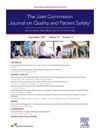Reducing Hospital Length of Stay: A Multimodal Prospective Quality Improvement Intervention
IF 2.4
Q2 HEALTH CARE SCIENCES & SERVICES
Joint Commission journal on quality and patient safety
Pub Date : 2025-01-31
DOI:10.1016/j.jcjq.2025.01.012
引用次数: 0
Abstract
Background
Prolonged hospital stays beyond medical necessity pose avoidable risks and costs. Reducing length of stay (LOS) without compromising patient outcomes is a national priority for hospitals. The authors aimed to systematically and safely improve LOS and LOS index (LOSI) at an urban academic safety-net hospital.
Methods
The research team conducted a multifaceted quality improvement initiative in a 550-bed hospital, focusing on improving LOSI and reducing LOS. Interventions included institutional investment in an LOS reduction program, development of rigorous internal LOS data analytics, and multiple Diagnosis Related Group (DRG)–focused LOS reduction initiatives (specifically, sepsis, obstetric, and psychiatric DRGs). Initial interventions occurred in mid-2019, with subsequent iterative improvement through 2023. Statistical analyses assessed pre- and postintervention outcomes.
Results
Mean LOSI significantly improved postintervention from 1.15 to 1.02 (-0.13, p < 0.0001), with sustained performance for more than three years. The average LOS demonstrated a non–statistically significant but clinically relevant improvement from 6.24 to 5.91 days (-0.33 days, p = 0.45). Excluding outlier long-LOS encounters, the LOS demonstrated a statistically significant improvement in the postintervention slope change (-0.02 per month, p = 0.04), indicating a delayed improvement to LOS postintervention. There were no adverse effects on readmissions or mortality.
Conclusion
A multifaceted approach to LOS and LOSI improvement in a safety-net hospital yielded clinically significant and sustained results, showcasing the value of integrated strategies and organizational commitment.
缩短住院时间:一种多模式的前瞻性质量改善干预措施。
背景:超出医疗需要的长期住院造成了可避免的风险和成本。在不影响患者预后的情况下缩短住院时间(LOS)是医院的国家优先事项。旨在系统、安全地提高城市学术保障医院的LOS和LOS指数(LOSI)。方法:研究小组在一家拥有550个床位的医院开展了多方面的质量改进活动,重点是改善LOSI和降低LOSI。干预措施包括对减少LOS项目的机构投资,开发严格的内部LOS数据分析,以及以诊断相关组(DRG)为重点的多个LOS减少举措(特别是败血症、产科和精神科DRG)。2019年年中进行了初步干预,随后在2023年进行了迭代改进。统计分析评估了干预前后的结果。结果:干预后平均LOSI从1.15显著改善到1.02 (-0.13,p < 0.0001),并持续表现超过三年。平均LOS从6.24天改善至5.91天(-0.33天,p = 0.45),无统计学意义,但具有临床意义。排除异常的长期LOS接触,LOS在干预后的斜率变化方面显示出统计学上显著的改善(每月-0.02,p = 0.04),表明干预后LOS的改善延迟。再入院率和死亡率均无不良反应。结论:对安全网医院的LOS和LOSI改善采取多方面的方法取得了临床显著和持续的结果,显示了综合战略和组织承诺的价值。
本文章由计算机程序翻译,如有差异,请以英文原文为准。
求助全文
约1分钟内获得全文
求助全文
来源期刊

Joint Commission journal on quality and patient safety
HEALTH CARE SCIENCES & SERVICES-
CiteScore
3.80
自引率
4.30%
发文量
116
审稿时长
49 days
 求助内容:
求助内容: 应助结果提醒方式:
应助结果提醒方式:


